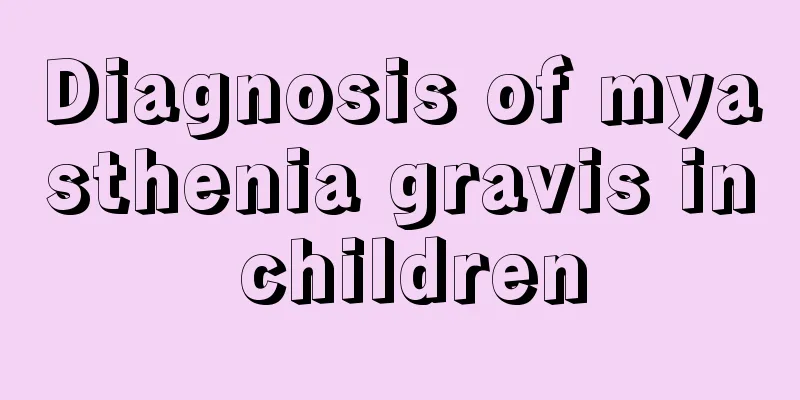Diagnosis of myasthenia gravis in children

|
Most of the symptoms of myasthenia gravis come from muscle weakness or even certain obstructions in the body's motor functions. Generally speaking, myasthenia gravis is divided into two types, one is congenital and the other is acquired. The following article will introduce to you how to deal with myasthenia gravis in children. The diagnosis of myasthenia gravis should be differentiated from other diseases. The ocular muscle type should be differentiated from congenital ptosis and neurogenic ptosis; the bulbar type and systemic type should be differentiated from polymyositis, acute polyradiculitis, and brainstem encephalitis. 1. Differential diagnosis of myasthenic crisis (Table 1) Myasthenia gravis patients may experience two types of crises, namely myasthenic crisis and cholestatic crisis. The clinical manifestations of the two crises are very similar, both showing severe muscle weakness and respiratory failure. The former often has a history of infection, trauma, mental shock or irregular medication; the latter may be accompanied by manifestations of cholestatic hyperfunction, such as pallor, sweating, diarrhea, muscle tremors, pupil constriction, cold and wet skin, etc. When identification is difficult, the Tensilon test can be performed. If the symptoms improve after medication, it is myasthenic crisis; otherwise, it is considered to be cholestatic crisis. 2.MG acute myasthenia should be differentiated from other acute paralytic diseases, including: (1) Periodic paralysis: It often occurs at night. When waking up, the patient finds that the limbs are weak. When the disease occurs, the blood potassium is low and U waves appear on the electrocardiogram. Each attack lasts for several days and is effectively treated with potassium supplementation. (2) Acute inflammatory demyelinating polyradiculopathy: Fever or diarrhea occurs at the beginning of the disease. In addition to limb paralysis, there is also nerve root traction pain and protein-cell separation in the cerebrospinal fluid. (3) Myelitis: fever and three major symptoms and signs of spinal cord damage (including upper motor neuron paralysis, transverse sensory impairment and urinary dysfunction). 3. Chronic muscle weakness needs to be differentiated from the following diseases, including: (1) Oculomotor nerve palsy: In addition to ptosis, the pupil may also be dilated and the upward, downward and adduction movements of the eyeball may be limited, which is seen in neuritis or intracranial aneurysm. (2) Polymyositis: proximal muscle weakness and pain in the limbs, elevated muscle enzymes, and inflammatory cell infiltration in muscle biopsy. (3) Muscular dystrophy: slowly progressive limb weakness, muscle atrophy, winged scapula in children, pseudohypertrophy of the gastrocnemius muscles, elevated blood myoglobin levels, and a family history. (4) Mitochondrial myopathy: Skeletal muscles are extremely intolerant to fatigue, and the symptoms are complex and varied. Blood lactate is elevated, and irregular red-edged fibers can be seen in muscle biopsy, and electron microscopy shows abnormal mitochondria. (5) Glycogen storage disease: Especially in type II patients, acid maltase deficiency causes limb girdle muscle weakness and respiratory muscle paralysis. It is easy to misdiagnose. PAS staining of muscle biopsy can show glycogen accumulation. There is a family history. (6) Cancerous myasthenia: It is mainly seen in elderly patients with small cell lung cancer. The patient will experience limb weakness which is relieved by activity. Repeated high-frequency electrical stimulation of the nerve electromyogram shows an increase in myoelectric potential. (7) Motor neuron disease: In the early stage, it only manifests as tongue and limb muscle weakness, and the physical signs are not obvious, making it difficult to identify. However, if muscle atrophy, muscle fiber fibrillation or pyramidal tract signs occur, it is not difficult to identify. If you find that your child has myasthenia gravis, you should take him to the hospital for examination in time. As medicine is making progress day by day, everyone has certain coping measures for myasthenia gravis. I believe that with active treatment, you can return home. |
<<: Causes of tongue ulcers in children
>>: Introduction to myocardial injury in children
Recommend
What should I do if my child has eye inflammation? These methods can help mothers
Every parent hopes that the baby can grow up heal...
8 month old baby shaking his head
For mothers, they will notice any behavior of the...
Can stuttering be cured?
Many symptoms of stuttering are common in childre...
Methods and effects of acupuncture points for children
As we gain a deeper understanding of Chinese medi...
Can a six month old fetus survive premature birth?
It can be said that the physical constitution of ...
What happens when children drink beer?
Many adults like to drink beer, especially in the...
How to stop nosebleed in children?
Children are very prone to nosebleeds. There are ...
Why are children's lips white? There are several reasons
There are many reasons why a child may have pale ...
How many degrees does a child usually have a fever
First of all, our human body is considered to hav...
Prevention of red pimples on the baby's face
Many children are inevitably affected by the skin...
Newborn red birthmark, mothers must see
Red birthmarks are also a type of birthmark that ...
Symptoms of baby's stomach pain, four major symptoms to remind you
Infants and young children do not have the abilit...
Is it okay for children to eat grapes?
Children should eat more fruits because different...
What are the symptoms of spastic cerebral palsy in children?
Cerebral palsy in children is mainly a disease ca...
What to do if your child is irritable and short-tempered
As we all know, many children do not have very go...









